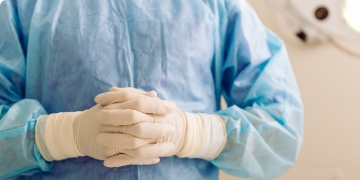
Parastomal Hernias
A parastomal hernia happens when part of the intestines bulge through the abdominal wall near a stoma.
A stoma is generally an opening in the small bowel or large bowel that allows you to pass waste into a bag. A patient might have surgery to create a colostomy (large bowel) or ileostomy (small bowel) if they have gastrointestinal problems that prevent them from having normal bowel movements.
The abdominal wall is the muscle that covers your stomach, intestines and other organs in your abdomen. Layers of tissue, fat and skin also make up the abdominal wall.
When you have an ostomy, the opening needed for your bowel to exit the intestinal cavity creates a weak spot in the abdominal wall, where a parastomal hernia can bulge out. Parastomal hernias are the most common complication of ostomy surgery.
Parastomal Hernia Causes and Risk Factors
There are certain factors that can increase a person’s risk of having a parastomal hernia after ostomy surgery.
Parastomal hernia risk factors include:
- Age: As you grow older, the muscles in your abdominal wall naturally lose some of their strength, making hernias more common.
- Abdominal pressure: Anything that causes pressure or straining in the abdomen can increase your risk of a hernia. This includes straining during physical activity, urinating, coughing or vomiting.
- Obesity: Having more fat tissue in the abdomen can create increased pressure and increase the chance of a hernia happening.
- Emphysema and other chronic lung conditions: Coughing and struggling to breathe can cause strain and increased pressure in the abdomen.
- Infection: After your original surgery, infections can prevent wounds from healing properly. This can make the muscles in the abdomen weaker.
- Genetic risk factors: Certain conditions can affect your connective tissue and make it more likely for a hernia to occur after surgery.
- Steroids: Taking certain types of steroids can lead to an increased risk of parastomal hernia.
Parastomal Hernia Symptoms
The most noticeable parastomal hernia symptoms are:
- A visible bulge in the abdominal wall near the stoma
- Prolapse of the stoma (the intestines push outside the body)
- Pain, pressure, aching or burning at the hernia site
- Difficulty with pouching your ostomy including ostomy bag leakage or poor fit
What are the complications of a parastomal hernia?
A parastomal hernia can become stuck (also called incarcerated), meaning the contents of the bulge cannot be massaged back inside the abdominal wall. This can lead to serious complications.
If a the contents of your parastomal hernia are stuck outside the abdominal wall, they may become strangulated. This happens when blood flow to the contents inside the hernia is cut off. Without blood flow, the tissues or parts of organs inside the hernia can die.
If a hernia is stuck or strangulated, this can cause intestinal obstruction and death of the strangulated intestine. This may require emergency surgery.
Strangulated hernia symptoms:
- A hernia bulge that is larger than before
- A hernia bulge that does not go back inside the abdomen
- Fever
- Redness in the area
- Sudden or severe pain
- Symptoms of intestinal obstruction, including abdominal pain, bloating, nausea and vomiting
A parastomal hernia can also make it more difficult to keep your stoma bag in place, which can cause skin problems and make it more difficult to conceal the stoma appliance.

Parastomal Hernia Testing and Diagnosis
To diagnose an incisional hernia, your doctor will ask about your medical history and symptoms, perform a physical examination, and in some cases order other tests.
Many parastomal hernias can be diagnosed with a physical exam of the stoma area.
In some cases, your doctor may order imaging tests and other types of tests to help diagnose a parastomal hernia. Imaging tests can also help check for complications. These tests include:
- Ultrasound: a kind of test that uses sound waves to create an image of your organs
- CT scan: a kind of test that uses a combination of x-rays and computer technology to create images
- MRI: a kind of test that takes pictures of your organs and tissues without using x-rays
- Blood tests: a kind of test that can check for infections and other complications caused by a strangulated hernia
Parastomal Hernia Treatment
Treatment for parastomal hernias can include surgical and nonsurgical management.
Nonsurgical Management
If the hernia is not severe, your doctor may recommend lifestyle changes and medical management. These options can help you avoid having surgery if possible.
Lifestyle changes, such as losing weight or quitting smoking, can reduce the symptoms of a mild parastomal hernia. Wearing a support belt can also help ease symptoms for some people.
Skin-protecting sealants can help manage skin problems caused by a stoma appliance leak.
A wound ostomy nurse can help you take care of your ostomy and parastomal hernia symptoms. Regular visits to a wound ostomy nurse are an effective part of nonsurgical management for some people with parastomal hernias.
Surgical Management
An incarcerated or strangulated incisional hernia requires surgery. Some people may also have surgery if the pain and other symptoms of their incarcerated hernia are severe.
Surgery for parastomal hernias involves repairing any damage to the tissues, gently putting the hernia back into the abdomen, moving the stoma, and placing surgical mesh to strengthen the abdominal wall.
There are different types of surgery for parastomal hernias, including open and minimally invasive techniques. Which type of surgery is best for you depends on your hernia, surgical history, overall health and other factors. If your doctor recommends surgery, they will discuss your surgical options and help you decide on the treatment that’s right for you.
- In open hernia repair surgery, the surgeon makes a cut near the hernia site to view and repair the hernia. The bulging tissue is gently put back inside the abdomen. After surgery, the surgeon typically uses stitches and mesh to close the abdominal wall.
- Laparoscopic hernia repair surgery uses smaller incisions than traditional open surgery. In laparoscopic surgery, the surgeon makes small cuts (each less than an inch long) in the abdomen. Small surgical tools go through these incisions to help the surgeon view and repair the hernia. The surgeon uses a thin scope with a camera to see the hernia during surgery. The bulging tissue is gently put back inside the abdomen using small surgical tools.
What should I expect before and after hernia surgery?
Hernia repair surgery, also called abdominal wall reconstruction, is the best way to fix a hernia and prevent it from coming back. There are steps you and your hernia care team can take before and after surgery to help you have a successful outcome.

Before Surgery
Your Washington University hernia surgeon will begin by asking about your medical history and symptoms, as well as your goals for life after surgery. This will help determine the best treatment option for your hernia.
Talking to your surgeon about your goals is an important step in deciding on treatment. Your surgeon will ask you what kinds of activities you want to return to after surgery. You and your doctor will also go over any other health conditions you have.
Before having hernia surgery, your doctor will make sure you are healthy enough for surgery. Maintaining a healthy weight and stopping smoking if you smoke can both improve your recovery after surgery. Being overweight or obese can increase the risk of recurrence (the hernia coming back after surgery). Smoking can cause complications with wound healing after surgery. Your hernia care team can help you find resources if there is anything you need to do to prepare for surgery.
General anesthesia is used in most hernia surgeries.
After Surgery
After surgery, you may have some pain or discomfort. The pain is usually mild and goes away within about 2 weeks after surgery.
Minimally invasive (laparoscopic) surgery uses smaller incisions than traditional open surgery. These techniques typically result in less pain, shorter hospital stays and faster recovery times.
After hernia surgery, many patients can go home the same day. Some people may need to stay in the hospital overnight. Your hospital stay may be longer if you are recovering from previous abdominal surgery, or if your hernia is more complex.
Your doctor will recommend when you can safely return to your usual activities. Most people are able to return to daily activities within about 3 to 5 days after surgery.
Prevention and Recurrence
After abdominal surgery, about 1 in 3 people will experience an incisional hernia. There are things you can do to reduce the risk of having an incisional hernia after surgery.
- Maintaining a healthy body weight can reduce the risk of a hernia caused by being overweight.
- Learning to safely exercise and lift heavy weights can reduce strain on the abdomen.
- Treating chronic coughs and chronic constipation can prevent strain on the abdominal wall.
- Following all recommendations, guidance and limitations after having surgery can reduce the risk of a recurrent incisional hernia happening near the surgical site.
Having a hernia of any kind puts a person at higher risk of having another hernia. When a hernia comes back after surgery, this is called recurrence. A recurrent hernia can be more complex and difficult to treat than the original hernia. Taking steps to prevent an incisional hernia after abdominal surgery is the best way to avoid this cycle of recurrence. If you do have an incisional or recurrent hernia, following recommendations from your care team can help you avoid having more complex hernias in the future.
Washington University Hernia Surgery
Washington University hernia surgeons provide personalized care for people with hernias. Our surgeons are specialists in minimally invasive abdominal wall reconstruction using laparoscopic and robotic surgery. Every hernia is different, so we tailor our approach for your best outcome. We are here to help you get back to your regular daily activities without the pain of a bulging hernia.


